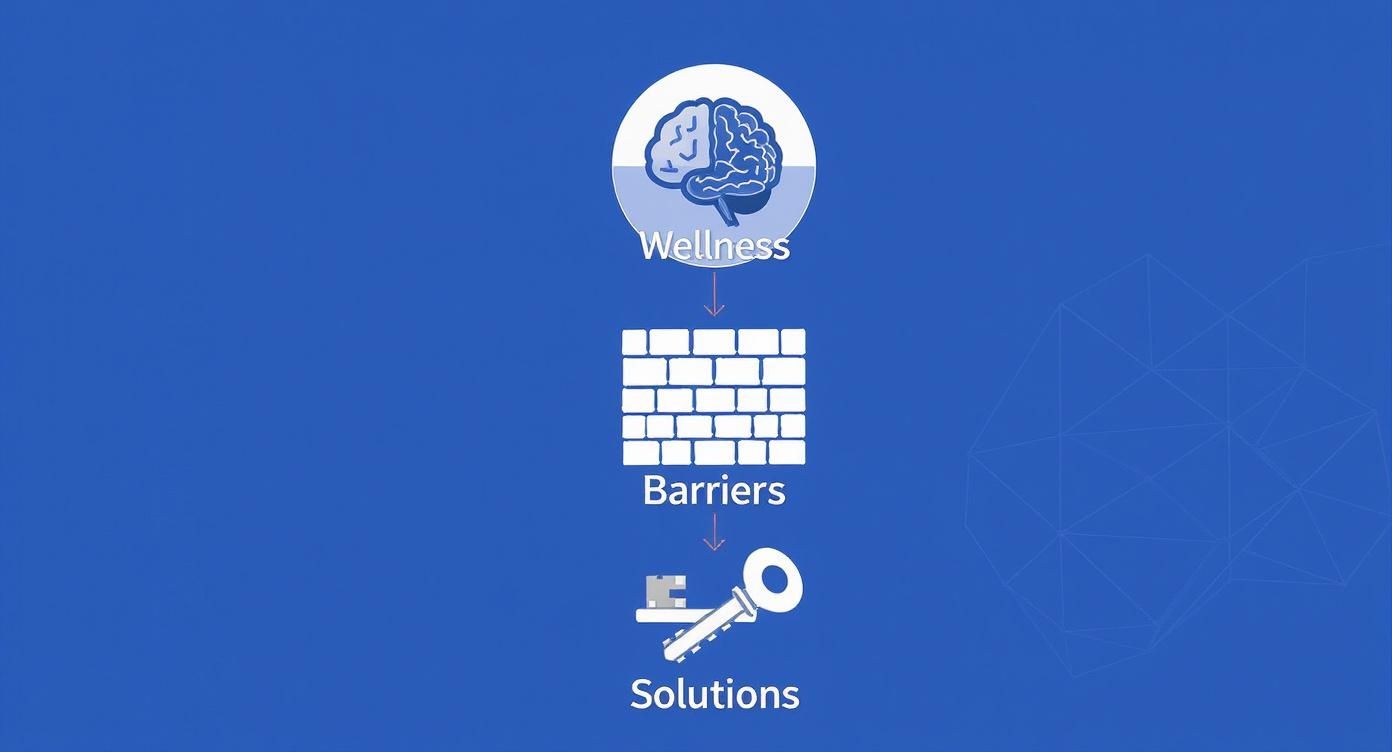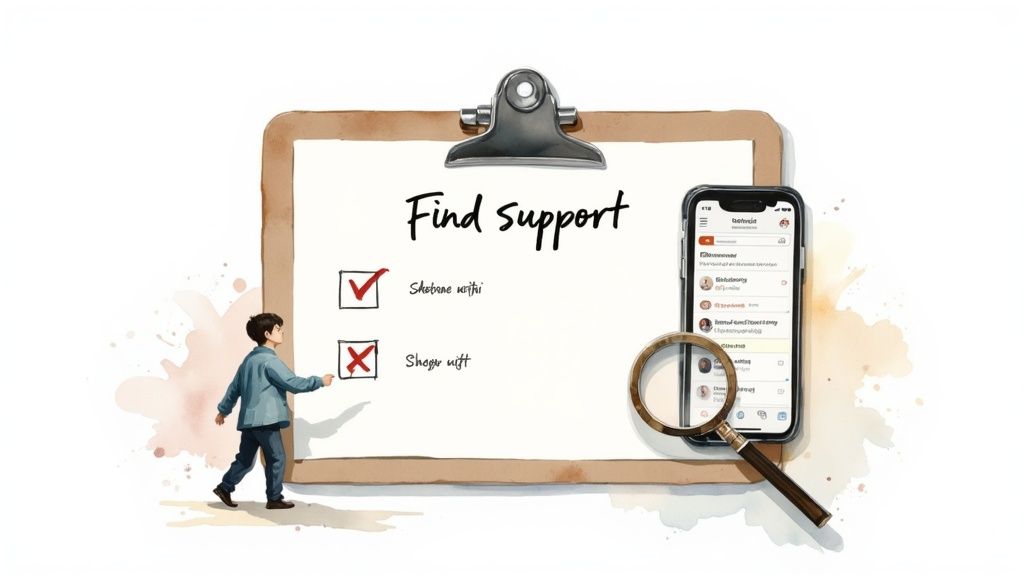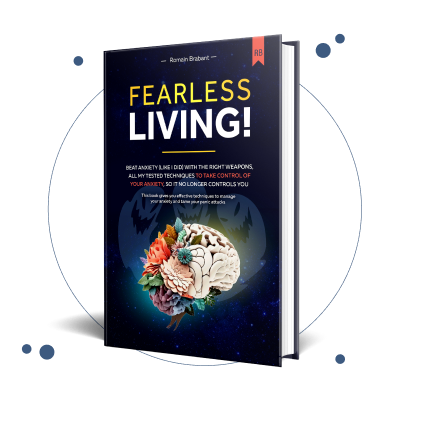
Thinking about getting help for your mental health can feel like staring up at a mountain. You know the view from the top will be worth it, but the path looks steep, winding, and full of obstacles. The biggest ones? Usually, it's the high costs, the stigma that still hangs in the air, and just the sheer frustration of trying to find the right person to talk to.
But these aren't permanent walls. They are challenges, and every single one has a solution. With the right map, you can navigate this path and find your way to a calmer, more peaceful life.
Your Path to Healing Starts Here
Let's start with a simple but powerful promise: a life where anxiety and panic don't call the shots is completely within your reach. Just deciding to face this journey is an act of incredible strength, and you don't have to walk it alone. That feeling of being stuck or overwhelmed? It's common, but it's not where your story has to end. Healing is possible, and you deserve it.
Think of this guide as your personal roadmap. We're here to light up the path, explore each common hurdle one by one, and give you real, actionable ways to get around them. We'll turn that confusion into clarity and that feeling of helplessness into empowerment.
Dismantling the Obstacles to Wellness
A lot of people think getting help is a complicated, soul-crushing process. And honestly, sometimes it can feel that way. It's a tough reality that nearly one in three people in the United States deal with mental health or substance use conditions, yet fewer than half of those with a mental illness actually get the care they need.
There are a lot of reasons for that gap, but understanding them is the first step to closing it for good.
This guide is designed to help you:
- Pinpoint the specific barriers that feel like they're holding you back.
- Find practical, real-world solutions for financial and logistical roadblocks.
- Build the confidence to ask for the kind of support you actually need.
- Challenge the stigma that can make reaching out feel so isolating.
"The journey of a thousand miles begins with a single step." Recognizing you deserve support and just looking for information? Those are monumental first steps. Every single thing you do from this point forward moves you closer to a future defined by hope and calm, not fear.
Our goal is to replace that "stuck" feeling with a sense of control and optimism. You are not alone, and the help you need is out there. Sometimes, the hardest part is just figuring out where to start.
If you're looking for immediate guidance and resources, you can explore options to get help now and take that crucial next step. Remember, seeing these barriers for what they are is the key to taking them down, piece by piece, and finally starting your journey to a panic-free life.
Understanding What Stands in Your Way
To find your way out of a maze, you first need a map of its walls. The same is true for getting mental health care. That blocked feeling isn’t just a vague sense of difficulty; it’s usually a mix of specific, identifiable barriers to mental health treatment. Getting to know these obstacles is the first—and most powerful—step toward tearing them down.
Think of it like trying to fix a car. You can't just start tinkering. You need to know if you're dealing with a dead battery, an empty gas tank, or a flat tire. By sorting out the challenges you’re facing, you can shift from feeling totally overwhelmed to creating a clear, hopeful plan for getting the help you deserve.
The path from knowing something is wrong to finding a real solution is a structured process. It’s not just a messy struggle. This visual guide below maps out that very pathway, turning an abstract idea into a clear, three-step journey.

The key takeaway here? For every barrier, there’s a solution waiting to be found. This makes the path to wellness something you can actually navigate. These barriers typically fall into one of three distinct categories.
To make this crystal clear, let's break down the three main types of roadblocks people run into when trying to get help. Each one requires a different strategy to overcome.
The Three Categories of Mental Health Barriers
| Barrier Category | Description | Common Examples |
|---|---|---|
| Structural | External, system-level problems built into the healthcare landscape. | High cost of therapy, lack of insurance coverage, long waitlists, shortage of providers in an area. |
| Attitudinal | Internal and societal beliefs, fears, and stigmas about mental health. | Fear of being judged, self-stigma (feeling weak), cultural or family disapproval of therapy. |
| Personal | Practical, day-to-day life circumstances unique to an individual. | Lack of time, childcare issues, transportation problems, feeling too overwhelmed to make calls. |
Now that we have a high-level view, let's dig into what each of these really looks and feels like in the real world.
H3: Structural Barriers: The Systemic Hurdles
Structural barriers are the big, external problems baked into the system itself. They're the logistical and financial roadblocks standing between you and a therapist's office. Imagine wanting to visit a friend, but the only bridge is out, the bus isn't running, and the toll for the one working ferry is sky-high. Those are structural issues.
These challenges are incredibly common and are a primary reason why so many people give up before they even get started. For example, in some areas, there's a severe shortage of mental health professionals, creating waitlists that can stretch on for months.
Here are a few key examples:
- High Costs of Care: Therapy sessions can be expensive, and insurance coverage is often confusing, limited, or just plain inadequate.
- Provider Shortages: There just might not be enough qualified therapists, psychiatrists, or counselors where you live, especially in rural communities.
- Long Waitlists: Even when you find someone who seems like a good fit, you might have to wait weeks or even months for that first appointment.
- Lack of Insurance Coverage: Many insurance plans offer surprisingly limited mental health benefits, and for many, not having insurance at all is the reality.
H3: Attitudinal Barriers: The Internal and Social Walls
Attitudinal barriers are rooted in beliefs, perceptions, and fears—both our own and those of the world around us. These are the invisible walls of stigma and shame that can make seeking help feel like admitting defeat.
If a structural barrier is a locked door, an attitudinal barrier is the paralyzing fear of what people will say if they see you turning the key.
This kind of barrier is incredibly powerful. A 2021 survey showed that nearly one-third of adults were worried about others judging them for seeking mental health care.
This fear of judgment—whether from family, friends, or coworkers—can be paralyzing. It convinces us to suffer in silence rather than risk being misunderstood or treated differently. Overcoming this requires courage and a shift in perspective, where we start seeing therapy not as a weakness, but as a proactive step toward strength.
These societal issues are significant. To fully address mental health challenges, it's crucial to acknowledge them as major societal issues; you can delve deeper into actionable problems, including mental health, affecting kids today.
H3: Personal Barriers: The Practical Life Challenges
Finally, personal barriers are the practical, individual circumstances that just make getting care difficult. These are the day-to-day realities of your life that get in the way.
If structural barriers are the broken bridge and attitudinal barriers are the fear of crossing it, then personal barriers are things like not having a car, not knowing the directions, or simply not having time to make the trip.
These obstacles are unique to your situation. They include not knowing where to even begin your search, feeling too overwhelmed by anxiety to pick up the phone, or struggling to fit appointments into a packed work or family schedule. These barriers are just as valid as the others and require practical, personalized solutions.
Navigating the Costs and Complexities of Care
For so many people, the path to getting help feels blocked by a massive, intimidating wall made of dollar signs and confusing paperwork. The fear of high costs and the maze of the healthcare system can be overwhelming enough to stop the journey before it even begins.
But this financial barrier, while very real, isn't a dead end. Think of it as a maze that, with the right map, you can navigate successfully. There is always a path forward.

The goal here is to transform that feeling of financial anxiety into a concrete plan you can actually use. Let's move beyond the scary price tags and explore practical strategies that put affordable, effective care within your reach. Healing from anxiety shouldn't be a luxury—it's a necessity, and there are ways to make it happen.
Financial hurdles and complex insurance policies are consistently among the biggest roadblocks to treatment. For a real-world example of how confusing coverage can be, understanding insurance limitations for essential care providers shows just how restrictive policies often are for many types of care. Unfortunately, mental health services often fall into this same confusing category.
Decoding the Cost of Treatment
It’s no secret that therapy can be expensive. In fact, financial barriers are one of the most common reasons people don't get the help they need. Over 50 million American adults live with mental health conditions, yet fewer than half receive any kind of treatment.
A huge part of the problem is cost. Traditional therapy sessions often run from $100 to $200 per hour, a price that’s simply out of reach for many people, especially if they don't have good insurance.
The stress of figuring out how to pay for care can feel like a heavy weight, especially when you're already struggling with anxiety. If this sounds familiar, check out our guide on finding financial anxiety relief to learn strategies for managing money-related stress while you plan for treatment.
Actionable Strategies for Affordable Care
High costs don't have to be the end of the story. The key is knowing where to look for affordable alternatives and how to make the system work for you, not against you. Here are several practical strategies to find care that fits your budget.
- Ask About Sliding-Scale Fees: Many therapists and clinics offer a "sliding scale," which means they adjust their fees based on your income. When you first contact a potential provider, one of the best questions you can ask is, "Do you offer a sliding scale or income-based rates?"
- Explore Community Mental Health Centers: These centers are often funded by local or state governments to provide affordable mental health care to the community. They are an excellent starting point for finding low-cost counseling and support.
- Look into University Training Clinics: Universities with psychology or counseling programs often run clinics where graduate students provide therapy under the supervision of licensed professionals. These services are typically offered at a much lower cost.
Navigating Your Insurance Benefits
Insurance can feel like a puzzle with half the pieces missing. Many plans "carve out" mental health benefits, which means they’re managed separately from your main medical coverage. This just creates extra hurdles and more confusion.
Don't be afraid to become your own best advocate. Call your insurance provider's member services line and ask direct questions: "What are my in-network and out-of-network mental health benefits?" "What is my deductible and copay for therapy?" "Do I need pre-authorization for treatment?"
This direct approach can save you from surprise bills and help you find a provider your plan actually covers. Understanding your benefits is a powerful first step in taking control of your healthcare journey.
Bridging the Access Gap
Beyond cost, another major problem is the sheer shortage of providers. An estimated 129.6 million Americans live in areas with too few mental health professionals. This shortage creates long waitlists and makes finding timely care incredibly difficult.
This is where telehealth has become a game-changer. Online therapy platforms connect you with licensed professionals from anywhere, bypassing geographical limits—and often at a more affordable price. Virtual sessions also cut out transportation costs and offer flexible scheduling, making care more accessible than ever before.
The takeaway? Cost doesn't have to be a permanent roadblock. With the right information, you can find a path forward to healing.
Breaking Through Stigma and Fear
While things like cost and logistics are very real barriers to mental health treatment, some of the biggest roadblocks are the invisible ones—the ones we carry around in our own heads. The heavy weights of stigma and fear can feel just as paralyzing as a six-month waitlist or an empty bank account.
These internal voices whisper that asking for help is a sign of weakness. They convince us to suffer in silence rather than risk judgment from the outside world or, even worse, from ourselves.
But what if we could flip that script? Reaching out isn't a failure; it’s a profound act of strength. It’s a declaration that you deserve to feel better and a commitment to building a life defined by healing, not hesitation. Your journey starts the moment you decide your well-being is non-negotiable.
Understanding the Two Faces of Stigma
Stigma isn’t some big, vague monster. It actually shows up in two distinct ways, and telling them apart is the first step toward taking away their power.
- Societal Stigma: This is the external stuff—the fear of how others will see you. It's worrying that friends, family, or coworkers might label you as "broken," "unstable," or "dramatic" if they find out you're in therapy. This fear is rooted in outdated and frankly, incorrect, ideas about mental health.
- Self-Stigma: This is the shame you turn inward. It’s that critical voice in your head telling you that you should be able to "just get over it" on your own. Self-stigma often takes those external judgments from society and makes them your own, leading to a deep sense of personal failure.
You are not your anxiety. You are a person experiencing anxiety. This small shift in language creates a powerful distance, reminding you that your condition is something you have, not something you are. It’s the difference between saying "I am a broken leg" and "I have a broken leg"—one is an identity, the other is a treatable condition.
Practical Tools for Challenging Stigma and Fear
Tackling these mental barriers doesn't require a giant leap. It’s about taking small, deliberate, and brave steps, one at a time. You don’t have to conquer fear overnight; you just have to take the next right step.
Start a New Conversation
The silence around mental health is what gives stigma its power. When you break that silence, even in a small way, it can be incredibly liberating.
- Choose Your Circle: You don't need to post about your journey on social media (unless you want to!). Start with one trusted person—a friend, family member, or partner who has earned the right to hear your story and will listen with empathy.
- Use "I" Statements: Keep the focus on your experience. Instead of "You just don't get it," try something like, "I've been feeling really isolated by my anxiety, and I could use your support." This invites connection instead of putting someone on the defensive.
- Set Clear Boundaries: It's totally okay to say, "I want to share what's going on, but I'm not looking for advice right now—just someone to listen." This puts you in control of the conversation.
Find Your Community
One of the most powerful antidotes to shame is realizing you're not alone. Hearing from others who genuinely get what you're going through validates your experience and creates a sense of belonging. The truth is, anxiety doesn't care who you are or what you do; it affects people from every walk of life. It can be a huge relief to see how many celebrities with anxiety have spoken openly about their own struggles.
Connecting with online forums, local support groups, or even just following mental health advocates on social media can help normalize what you're feeling. It helps replace that voice of self-judgment with one of self-compassion.
Reclaim Your Strength
Every single step you take toward getting help is an act of defiance against stigma. It's a vote for yourself and for a future where you are in the driver's seat.
Celebrate those wins, no matter how small they seem. Making the call. Scheduling that first appointment. Having that tough conversation. Each one is proof of your resilience and a powerful move toward the calm, peaceful life you deserve.
Your Toolkit for Finding the Right Support
Okay, now that we’ve pulled back the curtain on the barriers, it’s time to get practical. Let's build your toolkit for breaking through them, turning your plan into real, meaningful action.
Looking for the right support can feel like trying to navigate a new city without a map. But with the right tools in hand, you can find your way to lasting wellness, one step at a time. The goal here is to cut through the confusion and empower you to move forward with confidence. A life free from the grip of anxiety is absolutely possible, and finding the right professional to walk with you is a huge piece of that puzzle.

Demystifying Different Therapy Types
Therapy isn't one-size-fits-all. Different approaches resonate with different people, and knowing the basics can help you find a therapist whose style clicks with you. Think of it like finding an exercise routine you actually enjoy—some people love high-intensity workouts, while others find their groove in yoga. It's about what works for you.
Here's a quick look at two of the most common and effective therapies for anxiety:
- Cognitive Behavioral Therapy (CBT): This is a super practical, goal-oriented approach. CBT helps you become a detective of your own mind, learning to spot, challenge, and reframe the negative thought patterns and behaviors that keep anxiety going.
- Acceptance and Commitment Therapy (ACT): Instead of wrestling with anxious thoughts, ACT teaches you to accept their presence without judgment. The focus shifts to committing to actions that line up with your core values, helping you live a full life with anxiety, rather than letting fear call the shots.
Where to Find Help: Reliable Resources
Knowing where to even begin your search is half the battle. One of the biggest systemic hurdles is the global shortage of mental health professionals—the median is just 13 mental health workers for every 100,000 people, a gap that's even wider in lower-income countries. This makes knowing where to find reliable resources even more essential. The World Health Organization is actively working to scale up mental health services to address this challenge.
Here are some great places to start your search:
- Online Therapist Directories: Sites like Psychology Today, Zocdoc, and GoodTherapy are fantastic. You can filter by location, insurance, specialty, and the type of therapy you’re looking for.
- Professional Organizations: The American Psychological Association (APA) and the Anxiety & Depression Association of America (ADAA) both have "find-a-therapist" tools on their websites.
- Your Primary Care Doctor: Don't overlook your family doctor! They can often provide a trusted referral to a mental health specialist in your network.
- Mental Wellness Apps: Apps like Calm, Headspace, and BetterHelp offer immediate support, from guided meditations to access to licensed therapists.
- Psychiatrists for Medication Management: If medication might be part of your treatment plan, you'll need a psychiatrist. Our guide on finding a psychiatrist for anxiety has specialized advice to help you.
Questions to Ask a Potential Therapist
Finding the right therapist is a bit like dating—the chemistry and connection really matter. Most therapists offer a free 15-minute consultation call, which is your chance to interview them and see if it feels like a good fit.
Remember, you are in the driver's seat here. You have every right to ask questions and find someone you feel genuinely comfortable and safe with. This first call isn't a commitment; it's a conversation to see if you're on the same page.
Here’s a quick checklist of questions to have ready for that call:
- Experience: "What's your experience working with people who deal with anxiety or panic attacks?"
- Approach: "What therapeutic approaches do you use? Can you give me a sense of what a typical session looks like?"
- Logistics: "What are your fees? Do you offer a sliding scale, and what's your availability like?"
- Progress: "How do you track progress, and what can I generally expect in our first few sessions together?"
- Fit: This one is for you. As you're talking, check in with your gut. Do you feel heard? Respected? Your intuition is an incredibly powerful guide.
Taking these steps transforms the overwhelming task of "finding help" into a series of manageable, empowering actions. You have the tools—now you can start building your path to a calmer life.
It's Time to Write a New Story
You’ve navigated the costs, stared down stigma, and learned how to find the right person to talk to. That takes incredible strength. Just by reading this far, you’ve proven you’re committed to building a life defined not by anxiety, but by a quiet sense of calm.
The challenges are real, but they aren't walls. Think of them more like hurdles on a track. With the right strategy, you can clear every single one. You now have a practical guide for taking these overwhelming obstacles and breaking them down into small, doable steps.
Your Path to a Panic-Free Life
The way forward is all about using the tools we’ve covered. Every strategy is something you can actually use to reclaim control and start healing. While everyone's journey looks a little different, the core ideas are the same.
Here’s a quick recap of what you’ve learned:
- Money Doesn't Have to Be a Dealbreaker: Remember to look into sliding-scale fees, check out community health centers, and explore telehealth options. Don't be afraid to advocate for yourself with your insurance company—it’s a powerful move that can unlock care you can actually afford.
- Stigma is Just a Story—and You Can Rewrite It: Asking for help isn't weakness; it's one of the strongest things you can do. Fight back against self-stigma by being kinder to yourself, and chip away at societal stigma by having small, honest conversations with people you trust.
- The Right Help Is Out There: Use online directories, ask people you know for referrals, and don't be shy about "interviewing" a few therapists. Finding the right fit is a huge part of what makes therapy work, and it's totally okay to take your time.
A calmer, more peaceful life isn’t some far-off dream. It's a real possibility that you have the power to create. The same strength it took to even start looking for help is the strength that will see you through. Every small step forward is a win.
Moving Forward with Confidence
You’re not starting from square one. You're now equipped with the knowledge to dismantle the barriers that might have seemed impossible to get past. The road to feeling better is rarely a straight line, but every single effort you make builds momentum.
This journey is about more than just getting symptoms under control. It’s about getting back to a life filled with joy, connection, and a sense of purpose. You are more than capable of building that for yourself.
Take that next step. You’ve got this. In fact, you've already started.
Frequently Asked Questions
Figuring out this whole mental wellness thing can bring up a lot of questions. That's completely normal. This last section is all about giving you clear, straightforward answers to the stuff people wonder about most. The big takeaway here is simple: healing is always possible, and there's always a way forward.
What Is the First Step if I Feel Overwhelmed?
The simplest first step is often just talking to your primary care doctor. It might sound basic, but they can give you a referral and rule out any other health issues that could be contributing to how you feel. It makes the whole process feel much less intimidating.
Another powerful option is calling a confidential mental health helpline. These are staffed by trained professionals who can offer immediate, non-judgmental support and point you toward local resources, all with zero commitment. Just making that one call can make the entire journey feel less lonely and way more achievable. Our guide on when someone should talk to a mental health professional offers more insight into making this important decision.
How Can I Find Affordable Therapy Without Good Insurance?
Don't let cost be the final roadblock—plenty of options for affordable care exist. One of the best strategies is to look for therapists who offer a "sliding scale" fee, which means they adjust the cost based on your income.
You are not just a patient; you are a consumer of a service. It is completely acceptable and expected to ask about costs, payment options, and sliding scales upfront. A good provider will be transparent about their fees and may even suggest lower-cost alternatives if their practice is not a good financial fit.
Also, be sure to check out these resources for budget-friendly support:
- Community Mental Health Centers: These are often funded by local governments to provide low-cost services to residents.
- University Training Clinics: You can get high-quality care from graduate students (who are supervised by licensed professionals) at a much lower rate.
- Telehealth Platforms: Many online therapy apps have subscription plans that are a lot more affordable than traditional, in-person sessions.
How Do I Know if a Therapist Is a Good Fit?
Finding the right therapist really comes down to connection and comfort. Think of it like dating—you might have to meet a few people before you find "the one." Most therapists offer a free 15-minute consultation call, which is your chance to see if you click with their style and approach.
Use this call to ask about their experience with anxiety, the methods they use, and what a typical session feels like. But more importantly, pay attention to how you feel talking to them. Do you feel heard? Do you feel respected? It’s completely normal to shop around and speak with a few different therapists before finding the one who feels like the right partner for your healing journey.
At The Anxiety Checklist, we believe everyone deserves a life free from the grip of chronic anxiety. Our Fearless Living system provides a practical, self-guided toolkit to help you dismantle negative thought patterns, manage panic, and build a calmer future. Move from feeling overwhelmed to empowered with a clear, step-by-step plan you can start today. Learn more at https://anxietychecklist.com

